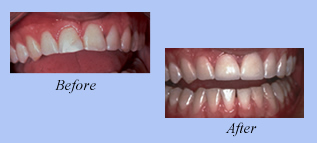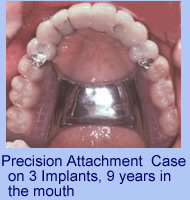UNIQUE RESTORATIVE OPTIONS FOR DENTAL TREATMENT
We offer solutions rarely offered to patients.
Solutions for patients who want the highest quality dentistry
Solutions for patients who cannot have sophisticated dentistry
Dental Restoration
In Dentistry, there are different ways to solve restorative problems. The key to success is choosing the right restoration for each particular patient. The optimal choice will depend on proper diagnosis of the problem, an analysis of the patient’s systemic and periodontal health, the overall restorative prognosis and consideration for the patient’s needs, limitations and desires. The types of restorations that can be offered are (in no particular order):
A. Restorations on Natural Teeth
- Partial Coverage Restorations (Fillings, Gold Inlays/Onlays)
- Full Coverage Restorations (Crowns and Bridgework on Natural Teeth
- Partial Dentures
- Clasp Partials
- Precision Attachment Partial Dentures
- Full Dentures
- Bonded (Composite Resin) Restorations (Porcelain Laminates or Veneers, Bonded Fillings, Laboratory Fabricated Composite Restorations)
B. Restorations on Implants
- Single Tooth Implants
- Fixed Bridgework on Implants
- Precision Attachment Partial Dentures with Fixed Bridgework on Implants
- Implant Overdentures
Bonding (Laminates, Veneers)
 Bonding is the application of a resin that contains a high concentration of fillers such as glass or quartz to the tooth structure. Bonding can be direct or indirect. Direct bonding is the application of composite resin directly to a tooth. Most tooth-colored fillings are direct bonded restorations.Indirect Bonding is the fabrication of acrylic, composite resin or porcelain restorations in the dental laboratory. The laboratory made restorations are then bonded to the teeth. Laminates or Veneers are examples of indirect bonding. They are thin shells of acrylic, composite resin or porcelain that are bonded to teeth or existing dental restorations. A new type of laboratory composite restoration called Tescera can be used to create inlays, veneers and crowns that can be bonded to teeth and existing restorations. Tescera is highly esthetic and more durable than directly bonded composite resin. Note how Porcelain Laminates transform the central incisors of this young adult.
Bonding is the application of a resin that contains a high concentration of fillers such as glass or quartz to the tooth structure. Bonding can be direct or indirect. Direct bonding is the application of composite resin directly to a tooth. Most tooth-colored fillings are direct bonded restorations.Indirect Bonding is the fabrication of acrylic, composite resin or porcelain restorations in the dental laboratory. The laboratory made restorations are then bonded to the teeth. Laminates or Veneers are examples of indirect bonding. They are thin shells of acrylic, composite resin or porcelain that are bonded to teeth or existing dental restorations. A new type of laboratory composite restoration called Tescera can be used to create inlays, veneers and crowns that can be bonded to teeth and existing restorations. Tescera is highly esthetic and more durable than directly bonded composite resin. Note how Porcelain Laminates transform the central incisors of this young adult.
(Read More About Cosmetic Dentistry)
Crown and Bridgework on Natural Teeth
 A crown (jacket) is a restoration that completely covers the tooth structure in three dimensions. Crowns can be made of metal (gold), acrylic, composite resin or combinations of these materials. Bridgework is the connection of individual crowns (splinting) to form a single restoration. A bridge often spans areas where one or more teeth are missing.
A crown (jacket) is a restoration that completely covers the tooth structure in three dimensions. Crowns can be made of metal (gold), acrylic, composite resin or combinations of these materials. Bridgework is the connection of individual crowns (splinting) to form a single restoration. A bridge often spans areas where one or more teeth are missing.
Read More About Crown and Bridgework
Precision Attachment Partial Dentures over Natural Teeth
 The Precision Attachment is a precision-machined male and female (key and lock) housing that connects a removable partial denture to fixed bridgework. Precision Attachment Partial Dentures can attach to fixed crown and bridgework on natural teeth and/or implants. A properly made precision attachment partial denture does not apply destructive lateral or gripping forces to the abutment teeth (teeth that contain the females to support the partial denture). As a result the abutment teeth last far longer than they would with a partial that has hooks, clasps or other locking mechanisms. In fact, because there is no rigid connection between the partial and the supporting abutment teeth, precision attachment partial dentures can be used with both natural teeth and implant restorations. The precision attachment partial denture is worn 24 hours a day and is only removed for hygiene. The males rarely require replacement, even after decades of use!
The Precision Attachment is a precision-machined male and female (key and lock) housing that connects a removable partial denture to fixed bridgework. Precision Attachment Partial Dentures can attach to fixed crown and bridgework on natural teeth and/or implants. A properly made precision attachment partial denture does not apply destructive lateral or gripping forces to the abutment teeth (teeth that contain the females to support the partial denture). As a result the abutment teeth last far longer than they would with a partial that has hooks, clasps or other locking mechanisms. In fact, because there is no rigid connection between the partial and the supporting abutment teeth, precision attachment partial dentures can be used with both natural teeth and implant restorations. The precision attachment partial denture is worn 24 hours a day and is only removed for hygiene. The males rarely require replacement, even after decades of use!
Read More About Precision Attachment Partial Dentures
Implant Supported Restorations
 Implants are” root” fixtures made of almost pure titanium that are inserted into the bone. Implants, like natural teeth, can support crowns and bridgework. Implants can also support precision attachment cases.
Implants are” root” fixtures made of almost pure titanium that are inserted into the bone. Implants, like natural teeth, can support crowns and bridgework. Implants can also support precision attachment cases.
Read more about Implant Supported Restorations
Implant Supported Precision Attachment Partial Dentures
 The precision attachment case can be created on implants as well as natural teeth. This type of case is far superior to an overdenture on implants because there are no front-back tipping forces, less tissue is covered by the restoration and the patient has fixed bridgework in the front. Fixed bridgework in the front allows the patient to bite into anything and can really enhance patient confidence and self-esteem.
The precision attachment case can be created on implants as well as natural teeth. This type of case is far superior to an overdenture on implants because there are no front-back tipping forces, less tissue is covered by the restoration and the patient has fixed bridgework in the front. Fixed bridgework in the front allows the patient to bite into anything and can really enhance patient confidence and self-esteem.
Read more about Implant Supported Precision Attachment Partial Dentures
